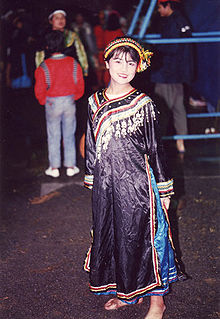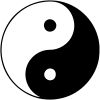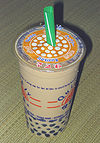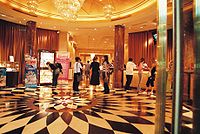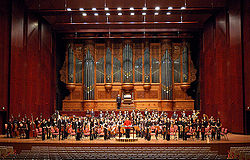- Culture of Taiwan
-
The culture of Taiwan is a blend of Confucianist Han Chinese, Japanese, European, American, global, local, and Taiwanese aborigines cultures, which are often perceived in both traditional and modern understandings.[1] The common socio-political experience in Taiwan gradually developed into a sense of Taiwanese cultural identity and a feeling of Taiwanese cultural awareness, which has been widely debated domestically.[2] Reflecting the continuing controversy surrounding the political status of Taiwan, politics continues to play a role in the conception and development of a Taiwanese cultural identity, especially in the prior dominant frame of a Taiwanese and Chinese dualism. In recent years, the concept of Taiwanese multiculturalism has been proposed as a relatively apolitical alternative view, which has allowed for the inclusion of mainlanders and other minority groups into the continuing re-definition of Taiwanese culture as collectively held systems of meaning and customary patterns of thought and behavior shared by the people of Taiwan.[3]
Contents
State Cultural Policy Overview
Historical context
Taiwan’s culture and cultural legacy has been largely shaped by the processes of imperialism and colonization as the structural and psychological effects of successive colonial projects have been integral to developing Taiwan’s self-image and the evolution of both official and unofficial Taiwanese culture (Yip 2004:2–5). For most of its colonized existence, Taiwan remained on the cultural margins, far from the centers of civil and cultural life of each regime, and with every regime change, Taiwan’s cultural center shifted. At various times Taiwan’s cultural center has been Indigenous Taiwan, Amsterdam, Xiamen (Amoy), Qing era Beijing, Imperial Japan, postwar China and even, arguably, the United States.[4]
Before the Qing Empire ceded Taiwan to Japan in 1895, Taiwan’s culture was characterized by Qing frontier societies of Han farmers and highland Aborigines. Due to Taiwan’s strategic location along East Asian trade routes, Taiwanese were also exposed to cosmopolitan influences and the effects of European commerce. By the middle of the Japanese era (1895–1945), Taiwan had begun to shift from local to contemporary global culture, under the guidance of Japanese style “westernization”. Beginning during Japan’s build up for war,[5] Japan invigorated its policies to Japanize Taiwan for mobilization against the Allies. Japan’s effort taught Taiwan’s elite, Japanese culture and language, but did not largely interfere in religious organization. When Japan’s suppressive wartime policies were lifted following World War II, Taiwanese were eager to continue with their prewar cosmopolitan activities.[6] Japan’s colonial legacy has shaped many of the customs and mannerisms of Taiwanese. Japan’s colonial legacy is still visible, due to Japan’s massive effort in constructing Taiwan’s economic infrastructure and industrial base, which is often cited as a major factor in Taiwan’s rapid economic development.[7]
KMT Era Cultural Policy
Main article: History of KMT cultural policyDuring the early postwar period the Chinese Nationalist Party “Kuomintang” (KMT) suppressed Taiwanese cultural expression and barred Taiwanese from cosmopolitan life except in the spheres of science and technology (1994 Winckler:29). The authoritarian KMT dominated public cultural space and Chinese nationalist networks became a part of cultural institutions, leaving little resource for cultural autonomy to grow.[8]
Under the early KMT, Taiwan was realigned from a Japanese imperial center to a Chinese nationalist center, under the influence of KMT and American geo-political interests.[9] Although American cultural activities were modest, they played a significant role in Taiwan’s developing cultural scene. The KMT claimed a loss of morale led to “losing China” and thus the state issued a series of ideological reforms aimed to “retake" China, which became the major state cultural program of the time. The immediate preoccupation with losing China diverted long term investment in the humanities and social sciences. On another level, the state’s main objective was to “sinicize” the Taiwanese by teaching them Mandarin Chinese and Nationalist ideology through compulsory primary education.[10]
By the late 1940s the KMT had eliminated dissent for its cultural policies. When Taiwanese had resumed the cultural activities, which were outlawed by the Japanese in 1937, the Nationalist attitude was that Taiwanese had been Japanese “slaves” and would therefore have to complete a period of moral and ideological tutelage before they could enjoy their full rights as citizens of the Republic of China.[11] The February 28 Incident destroyed Taiwan’s urban elite and the arrival of the mainlander elite ensured Nationalist domination of urban cultural centers.[12]
In 1953, Generalissimo Chiang Kai-shek issued his first major opinion on culture to complete Sun Yat-sen’s Three Principles of the People, which included prescribing Nationalist curriculum for education, building facilities for intellectual and physical recreation and the major state cultural program of promoting anti-communist propaganda (Winckler 1994:30). In regard to Taiwanese cultural life, the major thrust was for “universalization” of education in Mandarin, which was enforced by law. Despite the hard-line Chinese control over culture, the Soviet advances in technology led to a new Nationalist focus on building closer cooperation with American universities and developing engineering programs (Wilson 1970). The American presence in Taiwan also encouraged Taiwanese to resume some politically, ethnically neutral cultural activities, which was expressed in a flourishing Taiwanese language media market.[13]
Between the 1960s and the 1980s Taiwan's culture was commonly described in contrasts between Taiwan (Free China) and China (Communist China), often drawing from the official tropes of Taiwan as a bastion of traditional Chinese culture, which had preserved “true” Chinese values and culture against the “false” Chinese culture of post Communist China. At the same time, Taiwanese cultural expressions were brutally suppressed by Chiang Kai-shek and the Chinese Nationalist Party. In response to the Cultural Revolution of China, the government of Taiwan began promoting the Chinese Cultural Renaissance" (中華文化復興運動), with a myriad of programs designed to promote traditional Chinese culture to counter the communist movement on the mainland which aimed at uprooting the "Four Olds". These programs involved subsidized publication of Chinese Classics, the symbolic functions of the National Palace Museum, promoting famous prewar scholars to prominent positions in government and academic institutions, textbook and curriculum design with a focus on the official view of “traditional” Chinese culture and involvement in social and community events and the exemplification of Confucian ideology intertwined with Sun Yat-sen thought.
Taiwanization
After 1975
Bentuhua or Taiwanization/Taiwanese localization has become, arguably, the most important symbol of cultural change over the past twenty years. Bentuhua describes the social and cultural movement by the people of Taiwan to identify with Taiwan’s unique historical and cultural legacy. Bentuhua has often been associated with Taiwan Name Rectification Campaign, Taiwan Independence, and Taiwanese nationalism.
Religion
The prevalent form of religious belief in Taiwan is a blend of Buddhism, Taoism, and Chinese folk religion, including ancestor worship.[14] However, there are also large numbers of devotees to each of these belief systems.[15]
Christian churches have been active in Taiwan for many years, a majority of which are Protestant (with 2.6% of the population identifying themselves as Protestant)[15] with Presbyterians playing a particularly significant role. The Presbyterian Church in Taiwan has been active in promoting human rights and the use of the spoken and written Taiwanese (see Pe̍h-ōe-jī), both during Japanese rule, as well as the martial law period of the Republic of China, during which the exclusive use of Mandarin was legally mandated. As such, the church has been associated with the Taiwan Name Rectification Campaign and the pan-green coalition.
A number of Taiwanese religious organizations have extended their operations beyond the country. Several organizations, especially Buddha's Light International Association and Tzu Chi, have extended their operations around the world.
Buddhist-Taoist religious belief makes up 93%, Christian 4.5%, and others 2.5%.[16]
Food
Main article: Cuisine of TaiwanTaiwanese culture has heavily influenced the west: Pearl milk tea (also known as bubble tea or boba) is a popular tea drink available in many parts of the world. A notable Japanese influence exists due to the period when Taiwan was under Japanese rule. Taiwanese cuisine itself is often associated with influences from mid to southern provinces of China, most notably from the province of Fujian (Hokkien), but influences from all of China can easily be found due to the large number of Chinese who immigrated to Taiwan at end of the Chinese Civil War and when Taiwan was under Chinese rule (ROC). In the process, Taiwan developed a distinct style of cuisine.
Language
Most people in Taiwan speak both Mandarin Chinese and Taiwanese. Mandarin is taught in schools, however most spoken media is split between Mandarin and Taiwanese. Speaking Taiwanese under the Taiwanization movement has become a way for the pro-independence Taiwanese to distinguish themselves from the Mainlanders. The Hakka, who make about 10 percent of the population, speak the distinct Hakka language. The Aboriginal Taiwanese still speak their native languages, but most of them can also speak Mandarin and Taiwanese. English is taught universally, starting with middle school.
Some Japanese words have remained in common day use such as:
- 一極棒 (yijibang) from 一番 (ichiban) which means "the best".
- 便當 (biandang) from 弁当 (bentou) which means "boxed lunch".
- 歐巴桑 (oubasang) from おばさん or おばあさん (obasan / obaasan) which means "auntie" or "granny". The usage of this term can be offensive to women as it implies their youth has faded or refers to the term obatalian, an annoying bossy middle-aged woman.
- 歐吉桑 (oujisang from おじさん or おじいさん (ojisan / ojiisan) which means "uncle" or "gramps".
- 卡拉OK (kala OK) from カラオケ (karaoke) which is an amalgamation of "kara (empty) and orchestra". The usage of this term is in decline in favor of KTV.
Also developed Taiwan different expressions in Mandarin, which is called Taiwanese Mandarin.
- 土豆 (Tǔdòu, China) and 馬鈴薯 (Mǎlíngshǔ, Taiwan), meaning "potato".
- 軟件 (Ruǎnjiàn, China) and 軟體 (Ruǎntǐ, Taiwan), meaning "software".
- 自行車 (Zìxíngchē, China) and 腳踏車 (Jiǎotàchē, Taiwan), meaning "bicycle".
Sometimes the pronunciation with same characters differ such as 垃圾 is in China Lājī and in Taiwan Lèsè.
Media
Taiwan's freedom of press is guaranteed by the Constitution and its worldwide press freedom index ranks at 32 among 169 nations, as of 2007. Taiwan had been under martial law, with strict restrictions on the press and broadcasting, before political liberalization loosened restrictions in the 1980s.
Sports
Popular sports in Taiwan include:
- Badminton
- Baseball
- Basketball
- Cheerleading
- Golf
- Martial arts
- Pool
- Swimming
- Table tennis
- Tennis
- Volleyball
The United States National Basketball Association has a substantial following in Taiwan. Popular basketball players such as Allen Iverson, Kevin Garnett, Chauncey Billups, Andre Iguodala, Jason Williams, Karl Malone, Michael Jordan, Grant Hill, Clyde Drexler, Glen Rice, Kobe Bryant, and Scottie Pippen have visited Taiwan.
Athletes from Taiwan compete in international sporting events, often under the banner of "Chinese Taipei" due to China's opposition to the use of "Taiwan" under such circumstances.
Recreation
Karaoke is incredibly popular in Taiwan, where it is termed KTV (karaoke television). This is an example of something the Taiwanese have drawn, on scale, from contemporary Japanese culture. Pachinko is another example. During typhoons, many young Taiwanese will spend the day singing karaoke or playing mahjong. Many people enjoy watching miniseries collectively called Taiwanese drama.
Since 1999 hot springs, known as wēnquán in Chinese and onsen in Japanese, have been making a comeback thanks to efforts by the government. Over 100 hot springs have been discovered since the Japanese introduced their rich onsen culture to Taiwan, with the largest concentration on the northernmost part of Taiwan island.
Anime and manga are very popular in Taiwan. Comics, including manga, are called manhua in Taiwan. It is common to see a manga rental shop or a manga store every couple of streets in larger cities.
Convenience store culture
 Two 7-Eleven stores opposite each other on a crossroad. Taiwan has the highest density of 7-Eleven stores per person in the world
Two 7-Eleven stores opposite each other on a crossroad. Taiwan has the highest density of 7-Eleven stores per person in the world
Boasting over 9,200 convenience stores in an area of 35,980 km² and a population of 22.9 million, Taiwan has the Asia Pacific’s and perhaps the world’s highest density of convenience stores per person: one store per 2,500 people or .0004 stores per person.[17] As of 1 January 2009, Taiwan also has 4,800 7-Eleven stores, and thus the world’s highest density of 7-Elevens per person: one store per 4,786 people or .000210 stores per person.[16][18] In Taipei, it is not unusual to see two 7-Elevens across the street from or several of them within a few hundred meters of each other.
Because they are found everywhere, convenience stores in Taiwan provide services on behalf of financial institutions or government agencies such as collection of the city parking fee, utility bills, traffic violation fines, and credit card payments. Eighty-one percent of urban household shoppers in Taiwan visit a convenience store each week.[17] The idea of being able to purchase food items, drink, fast food, magazines, videos, computer games, and so on 24 hours a day and at any corner of a street makes life easier for Taiwan’s extremely busy and rushed population.
Convenience stores include:
- Circle K (Called OK in Taiwan)
- FamilyMart
- Hi-Life
- NikoMart
- 7-11
Cram school culture
See also: Gaokao and SuneungTaiwan, like its neighbors in East Asia, is well-known for its buxiban (補習班), often translated as cram school, and literally meaning "make-up class" or "catch-up class" or to learn more advanced classes. Nearly all students attend some sort of buxiban, whether for mathematics, computer skills, English, other foreign languages, or exam preparation (college, graduate school, TOEFL, GRE, SAT, etc.). This is perpetuated by a meritocratic culture that measures merit through testing, with entrance into college, graduate school, and government service decided entirely on testing. This has also led to a remarkable respect for degrees, including Ph.D.s and overseas Western degrees (US and Great Britain).
English teaching is a big business in Taiwan, with Taiwan, as part of its project to reinvigorate the Taiwan miracle, aiming to become a trilingual country—fluent in Mandarin, Taiwanese, and English. Many teachers come from English-speaking countries, such as the U.S., Canada, Great Britain, Australia, and New Zealand, and enjoy salaries of about $30,000–$50,000 per year at a low cost of living, with opportunities to manage or open one's own school and make several times that amount a year.
Popular culture
Cell phones are very popular in Taiwan. Mobile penetration rate stands at just over 100%. Because of their high use, phones in Taiwan have many functions and are becoming cheaper.
Internet cafes are very popular with teenagers. They often sell food. Many gamers eat while using the internet. Many parents and teachers are concerned with the amount of time youth spend in the internet cafes.
One of the best known figures in Taiwanese cinema is director Ang Lee, who has also made movies in the West and has won an Academy Award. Some popular pop artists in Taiwan include Leehom Wang, Jay Chou, Show Luo, Jolin Tsai and David Tao. Some of them have gained international fame and toured Asian countries like Japan, Malaysia and Singapore. Since Taiwan is well known for its entertainment scene, some of its TV stations have organised talent search to find new and young talents to join the big family of pop culture here. Some successful bands like S.H.E were formed in the talent search.
Hip-hop culture from the United States also flourishes in Taiwan. G-Unit and Eminem are also very popular. In this process, Taiwan produced several hip-hop artists, including Dog G, MC HotDog, Machi, and L.A. Boyz. Many young Taiwanese can be seen in throwback jersey, bling-bling, and baggy jeans which shows the effect of hip hop fashion in Taiwan.
Taiwanization of the culture of Taiwan has been a trend since democratisation in the 1980s and 1990s. In 2000, after half a century of Chinese Kuomintang (KMT) party rule, the first ever democratic change of ruling parties in Taiwan occurred with the election of Chen Shui-bian and his Taiwan-centric Democratic Progressive Party (DPP), marking an important step towards Taiwanization. While generally the KMT, the other major political party, is also more open to promoting Taiwan's cultural autonomy than in the past, the DPP made Taiwanization a key plank in its political platform. The Chen administration's policies included measures designed to focus on Taiwan while de-emphasizing cultural and historical ties to China. These policies included changes such as revising textbooks and changing school curricula to focus more on Taiwan's own history to the exclusion of China, and changing the names of institutions that contain "China" to "Taiwan". This sometimes led to incongruities such as Sun Yat-sen being treated as both a "foreign" (Chinese) historical figure and as the "Father of the Country" (Republic of China). These policies are called Taiwanization but have been attacked by detractors as "desinicization", which explains why these policies are generally applauded by most ethnic Taiwanese and opposed by the Chinese Nationalist Party.
One phenomenon that has resulted from the Taiwanization movement is the advent of Taike subculture, in which people consciously adopt the wardrobe, language and cuisine to emphasize the uniqueness of popular, groundroots Taiwanese culture, which in previous times had often been seen as provincial and brutally suppressed by Chiang Kai-shek.
The Kuomintang took power in 2008 with the election of Ma Ying-jeou to the presidency. The new KMT administration has controversially sought to reverse some of the desinicizing policies of the Chen administration, to various degrees of public support. The restoration of the Chiang Kai-shek Memorial Hall to its former state has been generally supported. By contrast, a directive by the administration to foreign missions to henceforth refer to visits by foreign dignitaries as "visiting (cultural) China" has been rescinded after criticism from DPP legislators.
Since 1949, Taiwan had managed to develop itself into the center of Chinese pop culture (also known as "C-pop" or 中文流行文化). Today, the Commercial Chinese music industry in the world (esp. Mandopop and Hokkien pop) is still largely dominated by Taiwanese pop artists. Successful Chinese pop artists from other countries (for e.g. Stefanie Sun, JJ Lin from Singapore) are also trained, groomed and marketed in Taiwan. Chinese pop artists from other countries who wish to become successful usually have to go to Taiwan to develop their music career. Mandarin Pop and Taiwanese (Minnan/Hokkien) genre music continue to flourish in Taiwan today.
Ever since 1990s, Taiwanese Variety Shows (綜藝節目) had grown from its home base in Taiwan to other parts of the world. Today, it is widely watched and enjoyed by the Overseas Chinese community in countries such as Singapore, Malaysia, Indonesia, America, etc.
See also
- Cinema of Taiwan
- Cuisine of Taiwan
- List of Taiwanese authors
- List of ethnic groups in Taiwan
- Media in Taiwan
- Music of Taiwan
- Photography of Taiwan
- Taiwanese drama
- Taiwanese opera
References
- ^ (Harrell/Huang 1994:1–5)
- ^ (Yip 2004:230-248; Makeham 2005:2-8; Chang 2005:224)
- ^ (Hsiau 2005:125–129); (Winckler 1994:23–41)
- ^ (Morris 2004:7–31);(Winkler 1994:28–31)
- ^ (Wachman 1994:6–7)
- ^ (Mendel 1970:13–14)
- ^ (Gold 1986:21–32)
- ^ (Phillips 2003:10–15)
- ^ (Gold 1994:47)
- ^ (Wachman 1994:82–88)
- ^ (Kerr 1965:72;266)
- ^ (Gates 1981:266–269)
- ^ (Winckler 1994:32)
- ^ TIO Gov Taiwan
- ^ a b taipei times
- ^ a b "Taiwan". The World Factbook. Directorate of Intelligence, Central Intelligence Agency. June 26, 2009. https://www.cia.gov/library/publications/the-world-factbook/geos/tw.html. Retrieved 1 July 2009.
- ^ a b Prevzner, Alexander (2004), "Convenience Stores Aim at Differentiation", Taiwan Business TOPICS 34 (11), http://www.amcham.com.tw/content/view/643/306/.
- ^ "International Licensing". 7-Eleven. 1 January 2009. http://www.7-eleven.com/AboutUs/InternationalLicensing/tabid/115/Default.aspx. Retrieved 1 July 2009.
Citations
- Chang, Maukuei (2005), "The Movement to Indigenize to Social Sciences in Taiwan: Origin and Predicaments", in John Makeham and A-Chin Hsiau, Cultural, Ethnic, and Political Nationalism in Contemporary Taiwan: Bentuhua, New York: Palgrave Macmillan.
- Hsiau, A-Chin (2005), John Makeham and A-Chin Hsiau, ed., Cultural, Ethnic, and Political Nationalism in Contemporary Taiwan: Bentuhua, New York: Palgrave Macmillan.
- Harrell, Steven (1994), "Introduction", in Huang Chun-chieh, Cultural Change in Postwar Taiwan, Boulder, Colo.: Westview Press.
- Makeham, John (2005), "Indigenization Discourse in Taiwanese Confucian Revivalism", in John Makeham and A-Chin Hsiau, Cultural, Ethnic, and Political Nationalism in Contemporary Taiwan: Bentuhua, New York: Palgrave Macmillan.
- Winckler, Edwin (1994), "Cultural Policy in Postwar Taiwan", in Stevan Harrell and Huang Chun-chieh, Cultural Change in Postwar Taiwan, Boulder, Colo.: Westview Press.
- Yip, June (2004), Envisioning Taiwan: Fiction, Cinema and the Nation in the Cultural Imaginary, Durham, N.C. and London: Duke University Press.
External links
Taiwan topics History TopicsPolitics Political parties · Government · Elections · Foreign affairs · Political (Legal) · Independence · Constitution · Administrative divisions · One Country on Each Side · Special non-state-to-state relationsSociety Demographics · Education · Ethnic groups · Healthcare · Human rights (LGBT rights) · International rankings · Languages · Religion · Smoking · WomenCulture Aborigines · Cinema · Communications · Cuisine · Holidays · Literature · Media · Music · Night markets · Opera · Photography · Sports · Tea · TelevisionEconomy Banks (Central bank) · Companies · Currency · Energy · Metropolitan areas · Stock exchange · Taiwan Miracle · Tourism · TransportationGeography Cities · Endemic species (protected) · Hot springs · Islands · Mountains · National parks · Rivers · Scenic areas · VolcanoesCulture of Asia Sovereign
states- Afghanistan
- Armenia
- Azerbaijan
- Bahrain
- Bangladesh
- Bhutan
- Brunei
- Burma (Myanmar)
- Cambodia
- People's Republic of China
- Cyprus
- East Timor (Timor-Leste)
- Egypt
- Georgia
- India
- Indonesia
- Iran
- Iraq
- Israel
- Japan
- Jordan
- Kazakhstan
- North Korea
- South Korea
- Kuwait
- Kyrgyzstan
- Laos
- Lebanon
- Malaysia
- Maldives
- Mongolia
- Nepal
- Oman
- Pakistan
- Philippines
- Qatar
- Russia
- Saudi Arabia
- Singapore
- Sri Lanka
- Syria
- Tajikistan
- Thailand
- Turkey
- Turkmenistan
- United Arab Emirates
- Uzbekistan
- Vietnam
- Yemen
States with limited
recognition- Abkhazia
- Nagorno-Karabakh
- Northern Cyprus
- Palestine
- Republic of China (Taiwan)
- South Ossetia
Dependencies and
other territoriesCategories:- Taiwanese culture
Wikimedia Foundation. 2010.

